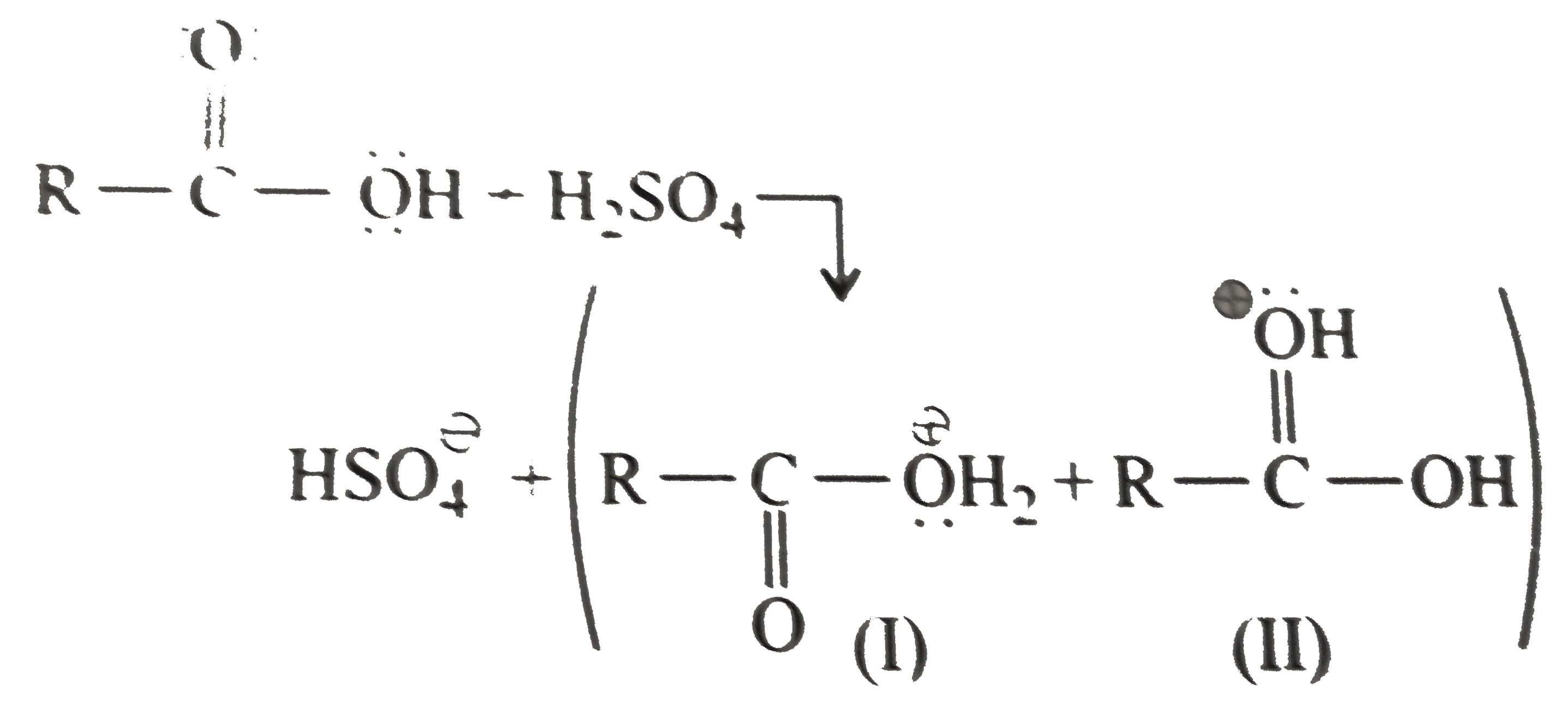(a) Write the reaction of RCOOH with conc.H2OS4 forming two possible cations.
(b) Give the relative stabilities of the cations.
( c) Which cation undergoes (C−O) bond cleavage more readily ?
(d) Calculate the van't Hoff factor, i (number of moles of particles formed per mole of solute), in both cases.
(a) 
(b) (II) is more stable and is the major cation since it has equal resonance contributing structures.
⎡⎢
⎢
⎢⎣R−.⊕:OH∣∣C−OH↔R−..:OH∣C−⊕O..H⎤⎥
⎥
⎥⎦
( c) (I) is more reactive. It forms acylium ion (RC≡O⊕) by losing H2O.
(d) If (I) is formed, it would lose H2O, which would accept H⊕ from H2SO4 , thus the net reaction and i would be :

If (II) is formed, the net reaction and i would be :

The experiment shows i=2.
Topper's Solved these Questions
- CARBOXYLIC ACIDS AND THEIR DERIVATIVESBOOK - CENGAGE CHEMISTRYCHAPTER - CARBOXYLIC ACIDS AND THEIR DERIVATIVESEXERCISE - Solved Examples
17 Videos
- CARBOXYLIC ACIDS AND THEIR DERIVATIVESBOOK - CENGAGE CHEMISTRYCHAPTER - CARBOXYLIC ACIDS AND THEIR DERIVATIVESEXERCISE - Exercises (Subjective)
19 Videos
- BIOMOLECULES, POLYMERS AND CHEMISTRY IN EVERYDAY LIFEBOOK - CENGAGE CHEMISTRYCHAPTER - BIOMOLECULES, POLYMERS AND CHEMISTRY IN EVERYDAY LIFEEXERCISE - QUESTION BANK
8 Videos
- CHEMICAL KINETICSBOOK - CENGAGE CHEMISTRYCHAPTER - CHEMICAL KINETICSEXERCISE - Archives Subjective
23 Videos
Similar Questions
The reactant which is entirely consumed in reaction is known as limiting reagent. In the reaction 2A+4B→3C+4D, when 5 moles of A react with 6 moles of B, then
(a) which is the limiting reagent?
(b) calculate the amount of C formed?
View SolutionA0.01 molal solution of ammonia freezes at −0.02∘C. Calculate the van't Hoff factor, i and the percentage dissociation of ammonia in water. (Kf(H2O))=1.86 deg molal−1.
View Solution
Knowledge Check
For reaction : A+2B40%−−→yield4C
If 10 moles of A and B each are taken calculate number of moles of 'C' formed are:A20B4C16D8Colligative properties of a solution depend upon the number of moles of a solute dissolved and do not depend upon the nature of the solute. However, they are applicable only to dilute solutions in which the solutes do not undergo any association or dissociation. For solutes undergoing such changes, van't Hoff introduced a factor, called van't Hoff factor (i). This has helped not only to explain the abnormal molecular masses of such solutes in the solution but has also helped to calculate the degree of association or dissociation.
The van't Hoff factor for 0.1 M Ba(NO3)2 solution is 2.74. The degree of dissociation isA91.3%B87%C100%D74%Which one of the following aqueous solutions will have the lowest freezing point ?
A0.1 molal solution of ureaB0.1 molal solution of acetic acidC0.1 molal solution of sodium chlorideD0.1 molal solution of calcium chloride
The reactant which is entirely consumed in reaction is known as limiting reagent. In the reaction 2A+4B→3C+4D, when 5 moles of A react with 6 moles of B, then
(a) which is the limiting reagent?
(b) calculate the amount of C formed?
View SolutionThe reaction of ethanol, C2H5OH , with oxygen is a popular classroom demonstration.Balance the equation to find the number of moles of gaseous products formed per mole of ethanol.
_C _2H_5OH(g)+_O_2(g)→_CO_2(g)+_H_2O(g)
View SolutionThe four colligative properties of the dilute solutions help in calulating the molecular mass of sthe solute which is often called observen molecular mass. It may be same as the theoretical molecular mass (calculated form rthe molecular formula) if the solute behaves normally in solution. In case, it undergoes association or dissociation. the observed molar mass gives different results. The nature of the in solution is expressed in terms of Van't Hoff factor (i) which may be 1 (if the solute behave normally), less than 1 (if the solute associates) and more than 1 (if the solute dissociates). The extent of association of dissociation is repreented by lapha which is :α=i−11/n−1(For association)ori−1n−1(for dissoviation)
(14) Benzoic acid undergoes demrisation in benzene solution. The Van't Hoff factor is related to degree of association α of the acid as :
View SolutionThe four colligative properties of the dilute solutions help in calulating the molecular mass of sthe solute which is often called observen molecular mass. It may be same as the theoretical molecular mass (calculated form rthe molecular formula) if the solute behaves normally in solution. In case, it undergoes association or dissociation. the observed molar mass gives different results. The nature of the in solution is expressed in terms of Van't Hoff factor (i) which may be 1 (if the solute behave normally), less than 1 (if the solute associates) and more than 1 (if the solute dissociates). The extent of association of dissociation is repreented by lapha which is :α=i−11/n−1(For association)ori−1n−1(for dissoviation)
(15) 0.1MK4[Fe(CN)6] is 60% inized. What will be Van't Hoff factor ?
View SolutionThe four colligative properties of the dilute solutions help in calulating the molecular mass of sthe solute which is often called observen molecular mass. It may be same as the theoretical molecular mass (calculated form rthe molecular formula) if the solute behaves normally in solution. In case, it undergoes association or dissociation. the observed molar mass gives different results. The nature of the in solution is expressed in terms of Van't Hoff factor (i) which may be 1 (if the solute behave normally), less than 1 (if the solute associates) and more than 1 (if the solute dissociates). The extent of association of dissociation is repreented by lapha which is :α=i−11/n−1(For association)ori−1n−1(for dissoviation)
(12) The Van't Hoff factor for diolute solution of glucose is :
View Solution
